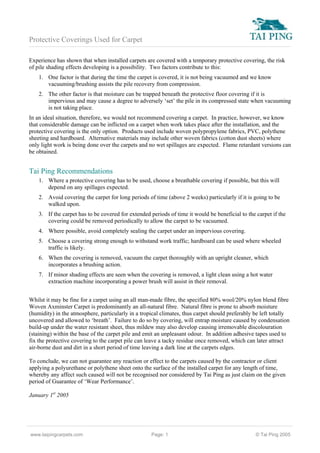
Tai Ping Temporary Protection Of Ax
- 1. Protective Coverings Used for Carpet Experience has shown that when installed carpets are covered with a temporary protective covering, the risk of pile shading effects developing is a possibility. Two factors contribute to this: 1. One factor is that during the time the carpet is covered, it is not being vacuumed and we know vacuuming/brushing assists the pile recovery from compression. 2. The other factor is that moisture can be trapped beneath the protective floor covering if it is impervious and may cause a degree to adversely ‘set’ the pile in its compressed state when vacuuming is not taking place. In an ideal situation, therefore, we would not recommend covering a carpet. In practice, however, we know that considerable damage can be inflicted on a carpet when work takes place after the installation, and the protective covering is the only option. Products used include woven polypropylene fabrics, PVC, polythene sheeting and hardboard. Alternative materials may include other woven fabrics (cotton dust sheets) where only light work is being done over the carpets and no wet spillages are expected. Flame retardant versions can be obtained. Tai Ping Recommendations 1. Where a protective covering has to be used, choose a breathable covering if possible, but this will depend on any spillages expected. 2. Avoid covering the carpet for long periods of time (above 2 weeks) particularly if it is going to be walked upon. 3. If the carpet has to be covered for extended periods of time it would be beneficial to the carpet if the covering could be removed periodically to allow the carpet to be vacuumed. 4. Where possible, avoid completely sealing the carpet under an impervious covering. 5. Choose a covering strong enough to withstand work traffic; hardboard can be used where wheeled traffic is likely. 6. When the covering is removed, vacuum the carpet thoroughly with an upright cleaner, which incorporates a brushing action. 7. If minor shading effects are seen when the covering is removed, a light clean using a hot water extraction machine incorporating a power brush will assist in their removal. Whilst it may be fine for a carpet using an all man-made fibre, the specified 80% wool/20% nylon blend fibre Woven Axminster Carpet is predominantly an all-natural fibre. Natural fibre is prone to absorb moisture (humidity) in the atmosphere, particularly in a tropical climates, thus carpet should preferably be left totally uncovered and allowed to ‘breath’. Failure to do so by covering, will entrap moisture caused by condensation build-up under the water resistant sheet, thus mildew may also develop causing irremovable discolouration (staining) within the base of the carpet pile and emit an unpleasant odour. In addition adhesive tapes used to fix the protective covering to the carpet pile can leave a tacky residue once removed, which can later attract air-borne dust and dirt in a short period of time leaving a dark line at the carpets edges. To conclude, we can not guarantee any reaction or effect to the carpets caused by the contractor or client applying a polyurethane or polythene sheet onto the surface of the installed carpet for any length of time, whereby any affect such caused will not be recognised nor considered by Tai Ping as just claim on the given period of Guarantee of ‘Wear Performance’. January 1st 2005 www.taipingcarpets.com Page: 1 © Tai Ping 2005
